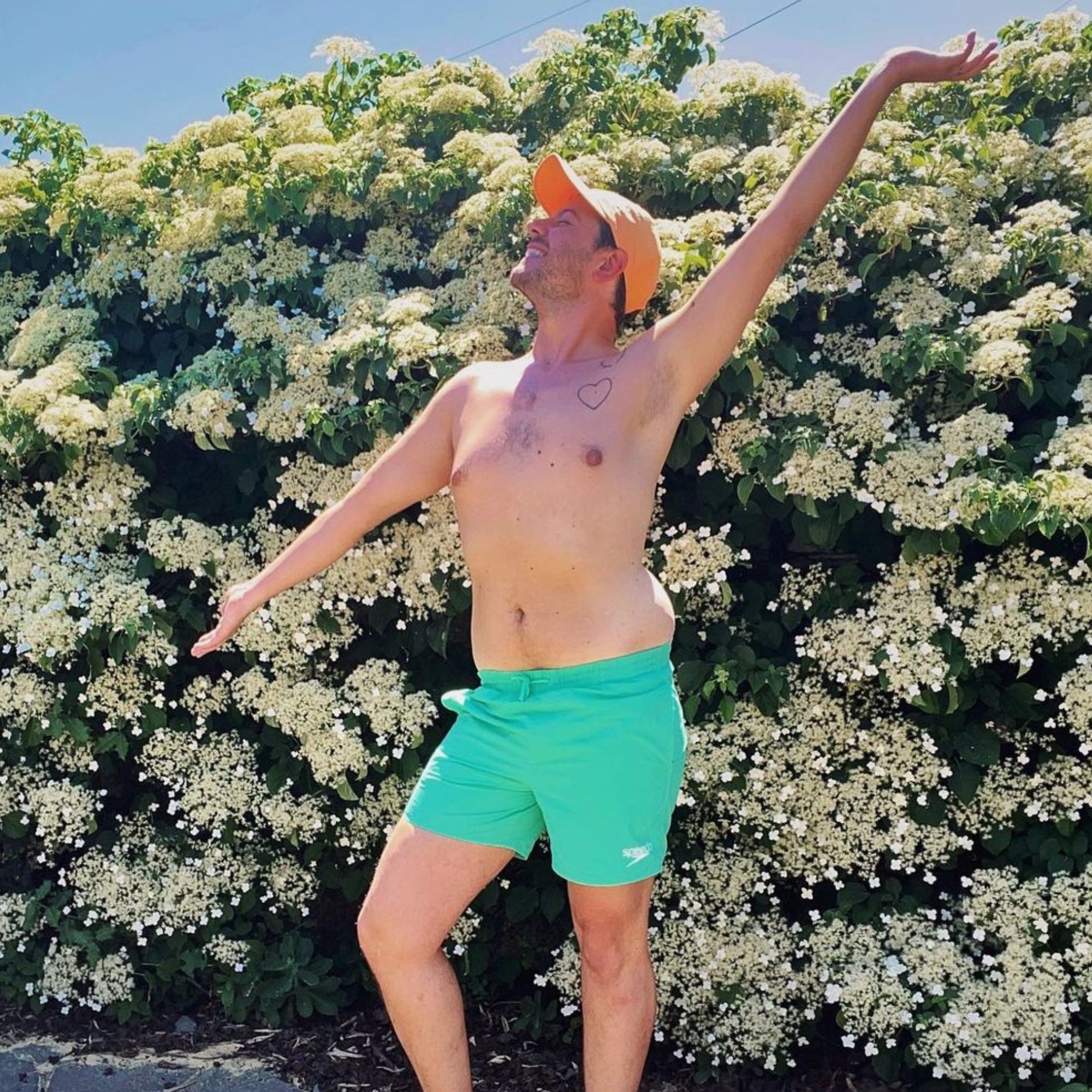
- POPSUGAR Australia
- Beauty
- I Got Naked and Talked Body Image, Self Acceptance and Toxic Tanning Culture With Jules Von Hep
I Got Naked and Talked Body Image, Self Acceptance and Toxic Tanning Culture With Jules Von Hep

Trigger warning: this article contains references to disordered eating which could raise concerns for some readers.
When I was 12, I read an interview with Charlotte Tilbury in Vogue. It was 2003, and the in-demand backstage makeup artist described the inspiration for the deeply bronzed beauty look she’d created at Stella McCartney’s Spring 2004 Paris show. It was Kate Moss, Christy Turlington and Naomi Campbell galavanting in Ibiza during the early 90s, sunbathing and drinking tequila with Phoebe Philo (then creative director at Chloé) and Stella herself.
Niche memory? Yes. But that one-pager made me want to be a makeup artist (The fantasy! The glamour! Nuxe Huile Prodigieuse and MAC Lip Glass!) and fortified my association between thin, tan bodies and coolness (Tequila! Friends!), adulthood and freedom (Ibiza! $10,000 a day!).
After all, if all of the models were deeply bronzed, 99 per cent of them were caucasian, and all of them were size 000.

Tanning has never been for everyone, and it certainly wasn’t for me.
Growing up in Australia during the 90s, I was far from the only person being made fun of for my skin tone on Sydney’s beaches. During this era, a specifically caucasian tan reigned supreme, one that was accompanied by blonde hair, blue eyes, and an athletic (but never bulky) physique.
While I’m extremely fortunate to not have been subject to the verbal and physical racial abuse I witnessed on Sydney’s beaches growing up, my extremely pale skin was described as “creepy”, “gross” and “disgusting” by other kids during torturous Saturdays at Nippers.
By 10 I was diagnosed with childhood anorexia, (a condition incidentally on the rise in Australian children aged 5-13) and later body dysmorphic disorder. The first has had lasting physical health implications for me as an adult, and the second is something I still struggle with. I’ll never be in a bikini without feeling like something that crawled out from under a rock.
So, when I was invited to meet with Jules Von Hep, founder of the tanning brand Isle of Paradise, and to receive a professional spray, I was concerned we’d have nothing to talk about. Somehow I’d managed to skirt tanning during my eight years in the beauty industry. I was very concerned about the tan itself.
Jules Von Hep’s Instagram persona is bright, warm and bubbly, all words I associate with tanning culture. As it turns out, he’s also a brutally honest and bitingly acerbic Virgo who shared a lot of my early experiences with tanning and body image.

Von Hep started his career in fashion during the 2000s. Struggling with an eating disorder himself, he was working in an industry where bullying and discrimination were considered part of the industry grind, and eating disorders part of the job description. Unsurprisingly, he found himself keen to leave, quickly. He was offered a gig with a major tanning company and made the leap into beauty.
Here he flourished, working with Kate Moss and Sienna Miller on shows like Dancing With the Stars. Soon enough, he was one of the most sought-after private tanners in London.
Despite beauty’s softer, fuzzier reputation, Von Hep noticed a disconnect between the representation he saw on shoots, and the people walking in into his private tent. “Every shoot was about white women on the beach,” he tells me. “Tanning was one-size-fits-all, and that was really reflected in the stories we were selling.”
What Is Tanning’s Story?
Firstly, says Von Hep, “My clients weren’t getting tans to go to the Maldives.” Rather, clients were tanning because they were going through divorces, were sick and wanted to look like themselves, or because they were working around the clock and wanted to feel like they’d had a holiday.
They were far from the jet-setting, happy-go-lucky blondes that represented the category in campaigns, but that’s hardly a surprise. After all, tanning has been about making white women look skinny and rich, rather than diversity, since it was first popularised in the 1920s.
When Coco Chanel returned home from the Maldives with a bit of a sunburn, tastemakers realised that one) tanning indicated you were wealthy enough to go on vacation, and two) it made you look thin.
The Great Depression and the Rise of Bovril as a Tanning Product
Having been plunged into two great depressions, British women found themselves using Bovril and tea to create an even skin tone in place of now-costly silk stockings, further accelerating demand for at-home tanning solutions.
For Von Hep, working in the 2000s felt like the industry hadn’t moved on, and the campaigns were shilling products that were just as limited. “The one-size-fits-all mentality trickled down to the products that were being formulated and sold,” he says. The objective at the time was to create skin that was one Cameron Diaz, pumpkin-spice-latte shade .
“They were all one undertone, they were flat, matte and drying,” Von Hep says.

If you were very fair, a good tan might mean taking you 30-40 shades darker. If you were deeper than Sally Hansen Airbrushed Legs Shade 4, you weren’t considered at all.
It was an era where women of colour shopping for a foundation were faced with five shades of beige at the drugstore, a world in which the only acceptable “tans” were ones paid for by white people. It was reflective of a profoundly racist culture, as alive and well in the beauty industry as it was on the runway.
Tanning in the 2000s was also just as classist as it was in 1920. “It was something that was laborious, finicky, and confusing,” says Von Hep. Tanning at home can take hours, and tanning in salon requires at least fortnightly maintenance. If you’re working 16-hour days, have kids or have a tight budget, adding tanning to your routine was not accessible or feasible.
It’s no surprise that, as Von Hep says, “people fell out of love with tanning, or they simply thought, ‘it’s not for me'”.
Frustrated by an inability to find the right products, Von Hep was faced with a choice: leave the beauty industry, or start his own brand and make the changes he wanted to see. He chose the latter, and Isle of Paradise was born in 2018.
Is There Anything Empowering About a Tan?
“When we launched Isle of Paradise it was all about empowerment,” Von Hep tells me. While “empowerment” is tossed around, Von Hep genuinely wanted his customers to feel like they were “in the driver’s seat”, and to feel they were highlighting their best features, rather than Barbie-fying themselves.
“I wanted people to feel good about themselves the way they are,” says Hep, rather than completely changing their skin tone.
Isle of Paradise products use colour-correcting technology over straight pigment, which means that wherever you sit on the Fitzpatrick scale, your tan will give you even skin, and a lit-from-within glow. Kind of like your favourite highlighter/tinted moisturiser combo.

The rest of the tanning industry hasn’t been quick to catch up.
While taking the range global in 2018 and 2019, Von Hep recalls one of many incidents where he was presented with 10, close to identical, size 8-to-10 caucasian models and asked to demonstrate the range of his Isle of Paradise brand.
“I said, ‘That’s not a demonstration, I need to see dimples, I need to see curves, I need to see brown and black skin’,” he says. When the organisers were unable to meet Von Hep’s request, they “ended up having to get someone from the crowd.” Dragging the industry along with him, Von Hep makes a point of collaborating with influencers of all shapes, sizes and backgrounds.
Is There Anything Empowering About a Tan?
For a large portion of this conversation, I stood topless in a G-string, arms raised in a makeshift hotel-room tanning booth. It was my first — and probably last — interview to take place topless, and having never had a professional tan, I realised just how intimate the process is.
As Von Hep explained that the tan would develop over the course of a few hours, I readied myself for disaster. But by the time I was out for dinner, my friends couldn’t notice. Indeed, the only way I knew I’d had a tan was by looking at the stark white outline left by my G-string. I felt glowing and luminous, but I wasn’t really a different “colour.” Indeed, I didn’t even need to change my foundation, I just added some bronzer and a warmer-toned blush.
So, was it “empowering”?
I work long hours and struggle with sleep and self-care at the best of times. This year I also experienced severe COVID, and a rare medication complication which resulted in rapid weight loss. I would say most of that weight dropped from my face, tits and arse and while I’ve gained some of it back, as we close in on the end of the year I’ve been feeling kind of haggard.
Gaining the weight back after a dramatic drop has been triggering. As someone with fairly well-managed BDD, small changes in my appearance — particularly my body — take a long time for me to adjust to, and as a note to others, please consider not telling people they look “tired,” or “healthy” when you see them. It’s unhelpful, like the several dermal therapists who strongly suggested it was time for filler.
Maintaining the tan does require a bit of mindfulness, whether you’re scrubbing it off or standing in front of the mirror waiting for it to dry. Spending more time looking at and touching my body has weirdly improved my relationship with it, and helped me recognise and accept some of the changes I’ve experienced this year.
Likewise, it acted like a bit of a health check. Having a “glow” made me look like someone who occasionally went for a walk during daylight hours, which made me realise that I kind of don’t, and possibly should.
In the end, Von Hep says he wants customers to feel rather than look like they’ve had a vacation. “I don’t tan to go to the beach,” he quips, “I tan to feel great while having rosé with the girls.”
Now, I probably will too.
Read More POPSUGAR Beauty
- These Vitamin C Products Are the Secret to Glowy Skin
- What to Know Before Trying the Copper Hair Colour Trend
- These 13 Lipsticks Are the Perfect Dupe for Charlotte Tilbury’s Pillow Talk
- Slay Or Nay: The Viral Beauty Trends of 2023 (and Whether They’re Worth Trying
- 16 of the Best LED Masks in Australia and Exactly What Each Light Does for Your Skin



